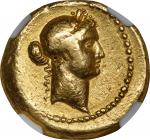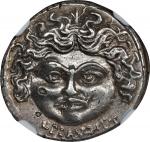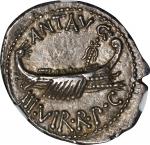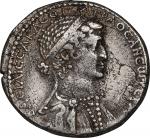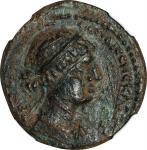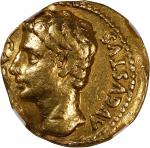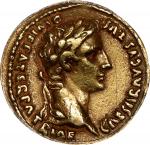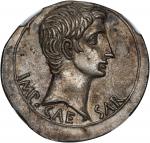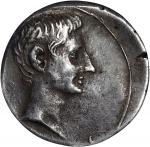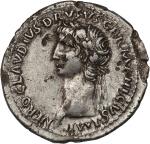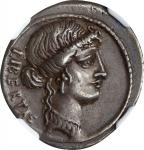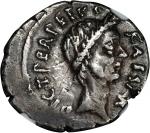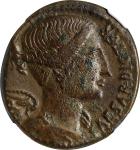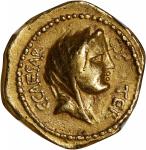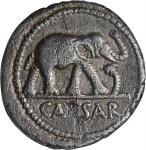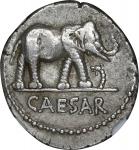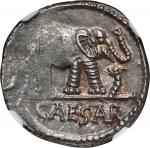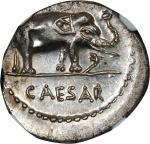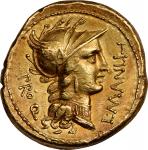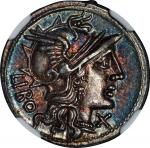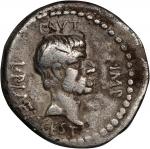M. JUNIUS BRUTUS. AR Denarius (3.76 gms), Military Mint traveling with Brutus and Cassius in western Asia Minor or northern Greece, 42 B.C. NGC VF, Strike: 5/5 Surface: 3/5. Cr-508/3; CRI-216; Syd-1301. Obverse: Bare head right; BRVT above, IMP to right; L - PLAET - CEST around to left; Reverse: Pileus between two downward-facing daggers; EID - MAR below. Lightly toned, with some scattered deeper areas nearer the edges and highlighting some of the devices. Fairly evenly handled and worn, and with a minor scuff on Brutuss head and near the top of the reverse, but nevertheless retaining good metal quality for the type and with, rather importantly, a very well-centered reverse. The iconic "double daggers" flanking the symbol of freedom, the Phrygian cap, are prominently displayed, with the historically important date of Caesars assassination, the Ides of March (<em>Eidibus Martiis</em> in Latin), clearly featured in abbreviated form. <strong>EXTREMELY RARE</strong> and undoubtedly at the top of the list with respect to the entirety of ancient numismatics. Given the charming state of preservation, one of the better examples of the top that one can hope to ever have the fleeting chance to acquire.<p><em>Among ancient numismatics, certain coin types quickly come to mind that everyone seeks out in order to have a well-rounded and represented collection--a collection that touches upon various important themes and topics of Mediterranean and Near East antiquity. A Tetradrachm of Alexander III "the Great," an Athenian owl, and an Elephant Denarius of Julius Caesar always populate such a list on account of either their ubiquity, historical connection, or both, while coins such as a Shekel of Tyre, a Widows Mite, and a "Tribute Penny" of Tiberius are also ceaselessly sought out owing to their reference, direct or tangential, within the Bible. None of these, however, come close to the stunning importance and timeless nature of the "EID MAR" Denarius of Brutus.</em><p><em>Struck during the late summer/early autumn of 42 B.C, roughly two-and-a-half years after the fateful, history-altering assassination of Romes dictator for life, Julius Caesar, the "EID MAR" Denarius was meant to convey Brutuss view that the latter had been slain for the good of the republic. The two daggers allude wholly directly to the means by which Caesar had been assassinated, with the Phrygian cap in the middle, an ancient symbol worn by freed slaves upon manumission, meant to reinforce the concept of the republics freedom from tyranny. Meanwhile, if this rather succinct iconography werent enough to remind the populace of the act commemorated, the timestamp of the assassination itself points specifically to it. Roman calendrical dating was slightly different than that with which we are familiar, with days referenced with respect to three specific points during the month. The Ides was treated as the 15th of "full" months, such as March, so the day on which Caesar was stabbed in the Senate would have been referred to in Latin as "</em>Eidibus Martiis<em>," or "on the Ides of March." So iconic and famous was this particular coin design that the classical author Cassius Dio, in </em>Roman History 47,<em> 25, 3, wrote that "</em>...Brutus stamped upon the coins which were being minted his own likeness and a cap and two daggers, indicating by this and by the inscription that he and Cassius had liberated the fatherland.<em>" Owing to the rather paltry survival rate of this fantastically important issue, even in lower, damaged grades, it remains a timeless type that would undoubtedly serve as the crowning achievement of any advanced collection of ancients. Recent auction records from just earlier this year point to the amazing growth and popularity of the type, with similar, slightly more attractive examples realizing total prices of ~$600,000 (in June) and $720,000 (in May). As such, the fervor for the present example should be rather enthusiastic and exceedingly spirited, as it represents an incredible opportunity for a keystone specimen.</em> From the Dr. Michael Rogers Collection, Part III.<p>Ex: Eucharius Collection (acquired from a Swiss collection in the 1960s).

